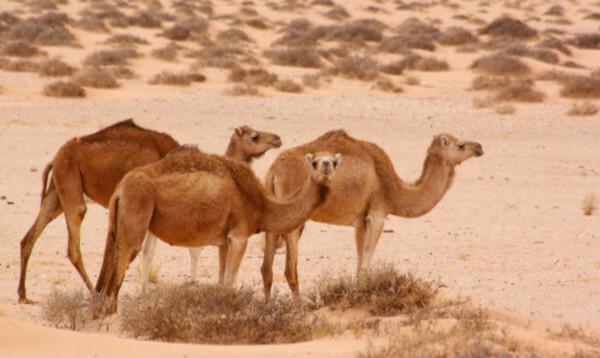camels are animals mammalyou belonging to the family camelid and to gender Camelus. They are animals of large size that can go long periods without eating and ingesting Water. They have two humps, which are fat reserves and help them in times of food shortage. These animals are found in some regions of the Asia, and, in recent years, its geographic distribution has decreased.
Read more: Leopards - carnivorous animals found in Africa and Asia
Camel Taxonomy
Camels are mammalian animals belonging to the family camelid and to gender Camelus. Wild and domestic camels are considered distinct species, those belonging to the species Camelus ferus, and these, to the species Camelus Bactrianus. see the classification complete taxonomy of the two camel species:
Kingdom: animalia
Phylum: Chordata
Class: Mammalia
Order: Cetarthiodactyla
Family: camelid
Gender: Camelus
Species: Camelus ferus and Camelus Bactrianus
General characteristics of camels
Camels are animals that present two humps formed by adipose tissue
, this being one of the most striking characteristics of these animals. Has body full of hair, dark brown or gray in color. Camels have a greater amount of hair in the hump, neck, head, front legs and tail. These hairs fall out when there is an increase in the temperature.
It is noteworthy that camels are adapted to live in places where the temperature can increase considerably, having some adaptations that allow them to live in these regions. Camels, for example, have few sweat glands, which causes them to have a low rate of sweating. They are able to tolerate an internal temperature rise of about six degrees before they start to perspire.
camels have long eyelashes, which help protect your eyes from sand and dust. Because they are found in regions of desert, are often subject to strong winds that can throw sand in their direction. In addition to the eyelashes, these animals are able to close their nostrils to protect themselves from these situations.
We can't help saying that camels are ruminant animals, that is, they have a stomach formed by four cameras. During the digestion process, food is swallowed and later returned to the mouth. Camels are normally considered herbivores, but some authors point out that they can feed on fish and other animals when vegetation is sparse.
Camels are large animals, reaching more than two meters tall. The length of the head and body is 2.25 m to 3.45 m, while the tail has a length of 0.35 m to 0.55 m. Adult camels can reach over 600 kg, with males being larger than females.
Wild camels usually occur in packs, although they are also seen alone. Bands typically have 6 to 20 members. The groups are formed by an alpha male, adult females and their offspring. Males, after reaching sexual maturity, are removed from the group by the dominant male and join other groups of males. These animals are not territorial.
Read more: Digestion of ruminants - occurs by a particular mechanism, differentiated from other animals
Camel feeding and hydration
Camels live in regions where there is often a shortage of water and food. To survive in these places, they rely on a series of adaptations. These animals usually feed on vegetables, removing, in addition to nutrients, water they need to survive. Furthermore, they are able to drink the brackish water of the desert, which has a higher salt content than the water present in the sea.
THE presence of humps it is also an important adaptation to the environment in which they live. Many people believe they are formed by water, but in reality they are large fat deposits. Camels use these reserves when they experience food shortages. One way to assess the degree of nutrition of these animals is to look at their humps. humps firm and upright indicate that the animal is well nourished, while the slanted and small humps indicate that the camels may be experiencing food shortages.
Read too: Rhinos - herbivorous mammals found in Africa and Asia
camel reproduction
Male camels mate with more than one female, the polygamous mating system. These animals live in groups made up of an alpha male, several females and their offspring. The alpha male mates with any female in the herd and also defends females from other wandering males. To drive away other males, camels tend to bite, spit, snort and fight.
Females usually give birth to one offspring after a gestation from 360 to 440 days. They are born weighing around 37 kg. Camels are weaned between the first and second year of age. You puppies remain with the mother until the age of three to five years, separating completely when they reach their sexual maturity. Full maturity usually occurs at age five. Camels can live for about 50 years.
Difference between dromedaries and camels

Dromedaries and camels are animals that belong to the same family and the same genus, being the dromedary belonging to the species Camelus dromedarius. The main difference between dromedaries and camels is that while the camel has two humps, the dromedary has only one. In addition, camels occur in Asia and dromedaries occur in Middle East, India and Africa.
By Vanessa Sardinha dos Santos
Biology teacher
